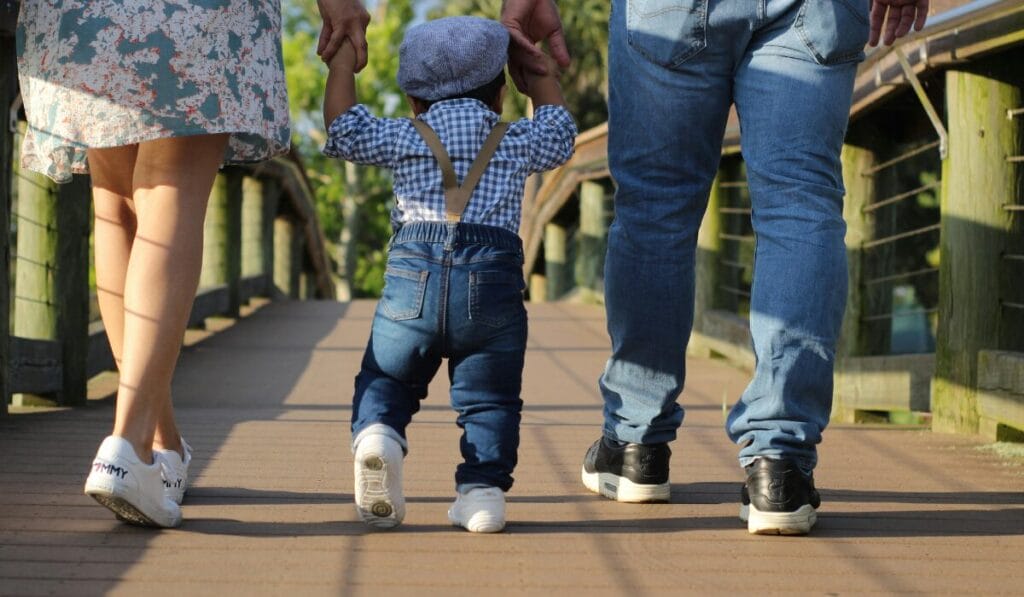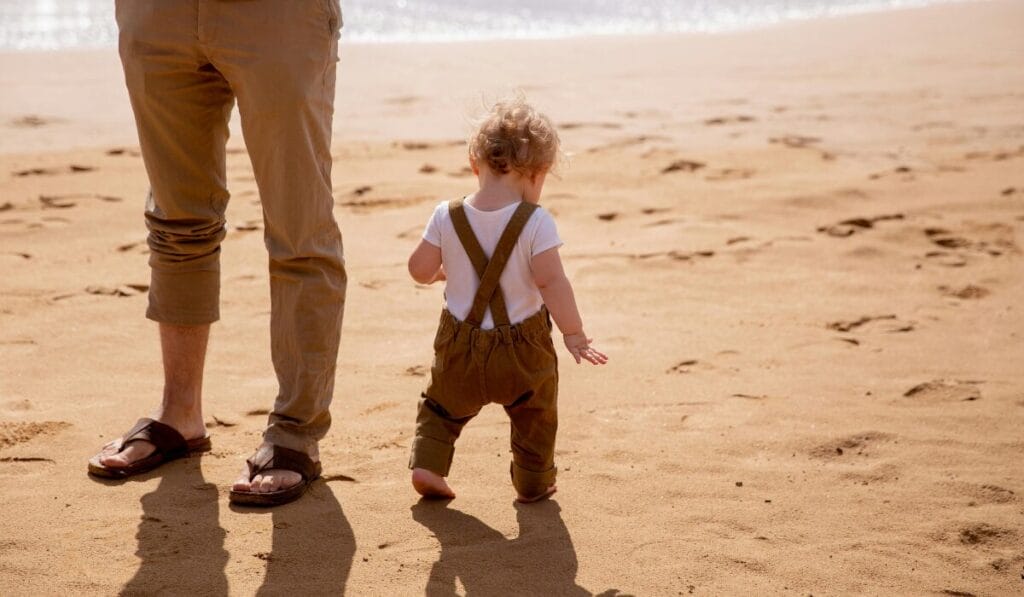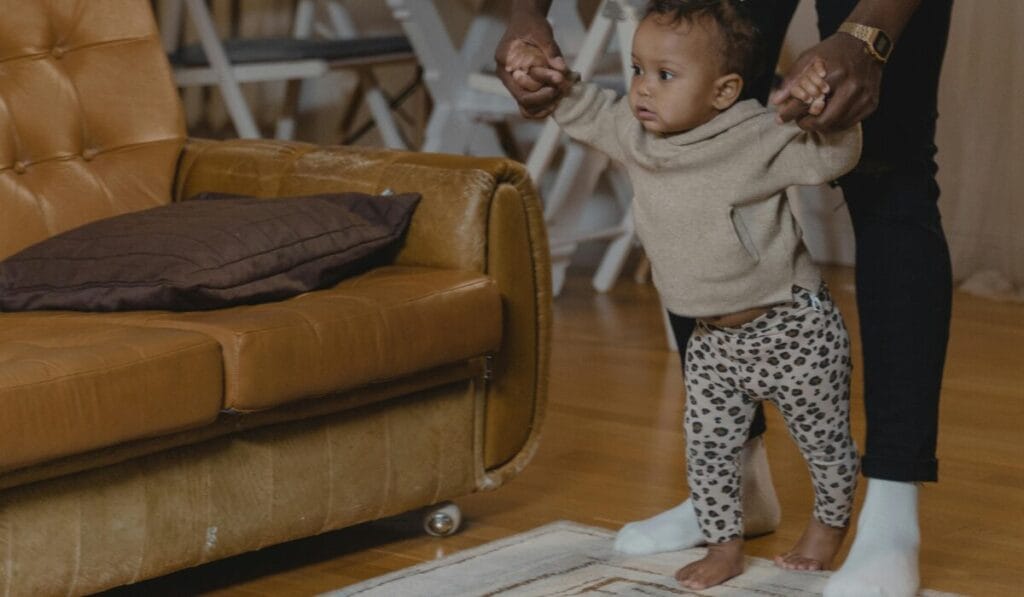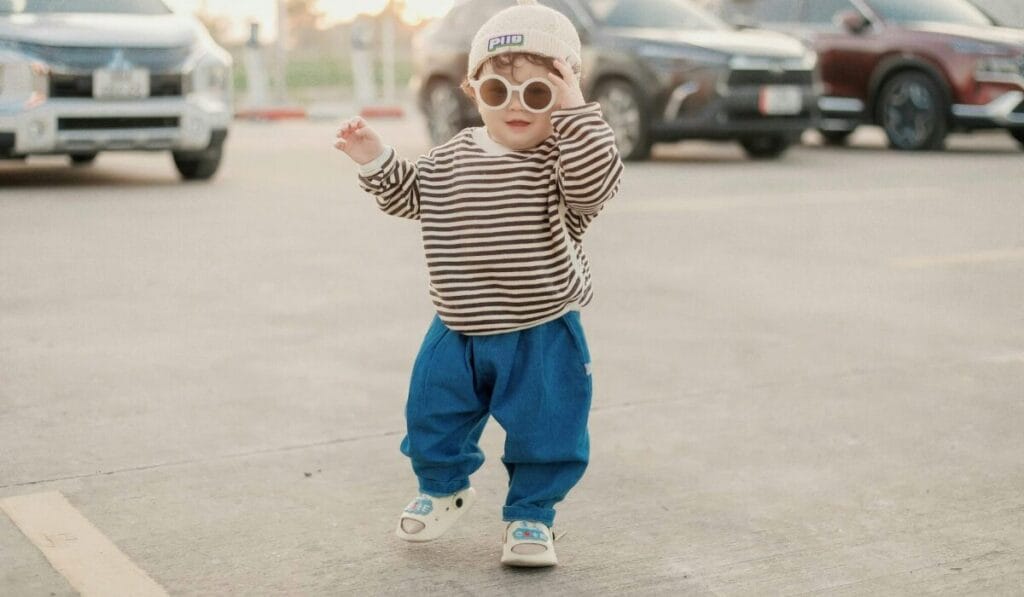When to Buy First Walking Shoes
When your child starts taking steady steps on his own, that is, walking confidently, then you should first buy walking shoes for your child. Usually, between 9 and 18 months, the child learns to walk confidently. Then choose shoes that are flexible and promote natural movement so that his feet are safe outside the house, and it is still useful for the child to walk without shoes indoors.
As you know, becoming a parent is not easy. This journey is full of milestones. It is a journey, the first smile of the child, the first words, and the most exciting are the small steps of the child that parents are waiting for. This is why when the child moves from crawling to standing and then walking, parents start thinking about when to buy their first walking shoes.
This is the decision that affects the comfort, development, and health of the child. In this guide, you will learn the right time to make this purchase, the key features these shoes must have, and the mistakes to avoid. So come here and choose the best shoes for the first steps of your little one.

👶The Right Time Matters
🚶♀️Wait Until Your Baby Starts Walking Independently
Experts agree that a child does not need regular walking shoes until they can walk confidently and independently for 15 to 20 minutes a day. Between the ages of 10 and 18 months, a child begins to develop walking shoes, and then the pace gradually increases until the time comes when they need regular walking shoes.
Why wait?
The strength of a child’s feet and muscles is significant, so give the child time to walk barefoot and do not put on walking shoes right away. Foot contact and natural walking are not only necessary for every child, but also the right of every child.
✅ Honest advice: If your child is still a toddler and is holding onto furniture or walking with the help of a cane, they don’t need shoes right now. Wait a little longer.
🧠Why the Right Timing is Crucial
👣Foot Development and First Steps
At an early age, every child’s feet are soft and flexible. Children’s feet continue to develop at this age, which is why introducing structural shoes so early is tantamount to stunting growth, which will also affect the child’s walking style and can lead to foot deformities.
However, if the child grows to the point where he starts walking on uneven or rough ground outside, then shoes become a necessity, and then wearing shoes is not a help but a protection.
👟What Happens If You Buy Too Early?
- Restricted foot movement: Due to reduced natural movement, growth may be delayed.
- Improper sizing: At this age, the child’s feet grow quickly, so the size can change quickly, so initial purchases may be problematic.
- Unnecessary expense: If the child is of high quality, the shoes will have to be purchased at a higher price, and then, when the shoes are old, they will have to be purchased again, and thus, more money will be spent.
🛒Choosing the Right First Walking Shoes
Once you’ve decided when to buy your first pair of walking shoes, the next step is to buy the best walking shoes. Going forward, you’ll know to buy shoes that provide natural movement and protect your feet without any restrictions.
📌 Key Features to Look For
Here’s what pediatricians and podiatrists recommend:
- Flexible soles
- Promotes the foot naturally.
- Reflects barefoot walking.
- Promotes the foot naturally.
- Lightweight and breathable materials
- Avoid heavy and stiff shoes.
- Look for soft shoes made of mesh and leather.
- Avoid heavy and stiff shoes.
- Non-slip soles
- Rubber with grip provides stability on various surfaces.
- Rubber with grip provides stability on various surfaces.
- Secure closure
- The Velcro straps, although not very strong, ensure a secure fit.
- The Velcro straps, although not very strong, ensure a secure fit.
- Room for growth
it is important to have adequate space for the fingers to move
🚫What to Avoid in Baby’s First Shoes
- Very thick and hard soles
- Sturdy ankles
- Protect children with arch supports
- Protect children from used shoes
🧑⚕️Pediatrician-Recommended Shoe Guidelines
Pediatricians and podiatrists set a few guidelines to consider when buying a baby’s first walking shoes:
📋The “Just Enough” Rule
Shoes should offer just enough:
- Comfort: Ensuring comfort
- Grip: High grip for stability
- Protection: Protection from heat, cold, and rough surfaces
🦶Importance of Proper Fit
Babies can’t tell if shoes are tight or loose, so make sure of the fit before purchasing:
- Sometimes the two pairs are different, so measure both feet.
- The fit often fits better on the larger foot.
- Check the shoes once the child can stand.
A baby’s feet grow quickly in the first two years, so be sure to have your baby’s feet measured at a reputable store within 6-8 weeks.

🌍Indoor vs Outdoor – When Shoes Are Needed
🏠At Home – Barefoot is Best
When a child walks barefoot at home, they get help with:
- better balance
- leg strength
- sensory development
Let the child walk on the floor without shoes, let them walk on the ground so that natural walking is not affected.
🌳Outside – Time for First Shoes
When the time comes for your child to start walking confidently outside, such as on grass, concrete, gravel, and in public places, understand that shoes are no longer a necessity but a safety precaution. Buying shoes has now become an essential part of life to protect your child’s feet from dangers and diseases.
💡Signs Your Baby is Ready for First Walking Shoes
If you’re still not sure when it’s time to buy your first walking shoes, consider these things:
- Walking for 10 to 15 minutes without support
- Exploring getting out and moving around
- Continuous improvement in leg strength, growth, and balance
- Adopting a walking habit that ignores crawling
When these signs appear in your child, consider that it is time to take the next step and start trying to buy walking shoes.
🛍️Best Times of Year to Buy First Walking Shoes
Time is not the only factor in development, but weather is also very important.
☀️ Summer
- Look for sandals, mesh uppers, breathable shoes, and lightweight shoes in the summer.
- Open options are always welcome, but make sure to wear a secure heel, not a casual one
❄️ Winter
- Buy waterproof shoes and sturdy shoes. It would be much better if there were a boot
- Shoes should be light; heavy shoes make a difference in balance.
- Whatever the season, give importance to fit and function rather than style.
⚠️Common Mistakes Parents Make
❌Buying for Looks Instead of Function
Not everything beautiful is good and safe. pay attention to strength and features instead of beauty.
❌Picking Shoes That Are Too Big
Some parents buy two cheap pairs so that they last longer, although this is wrong. Buy light and high-quality shoes, even if it is only one pair, and if it is two, it is very high-quality.
❌Overusing Shoes Indoors
Shoes take time to get used to the feet, often let children walk around the house so that the shoes return to their original condition.
🧳Travel and Daycare Considerations
If one’s child goes to daycare or is often on the go, parents may quickly gravitate towards walking shoes, which is fine in a way, but it’s not a good idea to make it a habit.
Always pack:
- Use soft, flexible shoes for outdoor use.
- Buy grippy socks and indoor shoes for daycare.

What Experts Say
According To SDJ (Hospital Sant Joande De Deu)
It is written on SDJ (Sant Joan de Deu Barcelona Hospital) that “for now, your child should walk barefoot without shoes. At this age, shoes can damage your child’s feet. When the child can walk, purchase walking shoes that are light, soft, and comfortable for them”.
Source: Hospital Sant Joan de Deu
According to “The Buds Life”
According to “The Buds Life,” When your child starts walking confidently and regularly, which is usually between 9 and 18 months of age, then he will need walking shoes outside the house, while still walking barefoot indoors will strengthen his feet.
Source: The Buds Life.com
Real Users Reviews
Review From Amazon
A verified user left a review about “Engtoy Baby Walking Sock Shoes” on Amazon that “We bought these sock boots for our daughter when she was 14 months old, who had gone from crawling to walking. These boots have helped my daughter a lot with her walking. They are easy to put on and comfortable. They run big.”
Source: Amazon.com
Review From Zappos.com
Another verified user left a review on Zappos.com that “These shoes are excellent. I bought them for my three-year-old and five-year-old sons. The fit is great and the size is perfect.”
Source: Zappos.com
🧩Conclusion When to buy first walking shoes?
When your child becomes confident, starts going outside, and can walk on the road, concrete, gravel, etc., then buying shoes for your child’s safety becomes a must. Walking shoes are a sign of your child’s development. Focus on this. Your focus should be on comfort, safety, and natural movement, not just style and fashion.
🙋♀️ FAQs
Q.1 When to buy walking shoes for a baby?
When your child starts walking confidently, then you should buy walking shoes for your child, and usually they start walking confidently about four to six weeks after starting to walk. Before that, soft shoes or socks are enough to protect their feet, and when they can, they walk, buy suitable shoes for themselves. These also provide balance to their feet and are a means of development.
Q2. How do I know when to buy new walking shoes?
Well, it depends on the child’s development and strength, but usually most children are able to walk between 9 and 18 months, and when they are able to walk, buy them lightweight walking shoes that are flexible and non-slip, with soles that protect your child’s feet well.
Q3. How do I know when to buy new walking shoes?
Your child’s walking shoes should be replaced every two to three months. However, if you feel tightness or see red marks or cracked soles or any other signs that indicate that the shoes are worn out, you should replace them. Because young children’s feet grow very quickly, you should also be careful about the size.
Q4. Can I put shoes on my 4-month-old baby?
No, you cannot put regular shoes on four-month-old babies because at this age, babies do not need shoes because they are not yet able to walk. This can damage their feet. At this age, they should use socks that keep their feet warm.
Q5: How to buy walking shoes before a child can walk?
You can buy them, but not walking barefoot naturally at home can reduce the child’s balance, and the muscles can remain weak.
Q6: How to find the right size of shoes?
There should be a gap of one finger in the front part, and walk a little in the shoes to check that they are not so tight that the feet feel pain, and not so loose that the feet move. Measure the child’s feet every 2-3 months.
Q7: Do children’s shoes have arch support?
No, children’s feet are flat, that’s why they don’t need arch support, the need for arch support comes later.
Q8: How to buy second-hand shoes for a child?
Not at all right. One is that there may be a risk of developing diseases and problems, and the other is that if those shoes are already loose, they can affect your child’s alignment and support.
Q9: What should I do if my child walks barefoot all the time?
This is a good thing until he gains self-confidence. Walking barefoot will help him develop balance and muscle strength.

